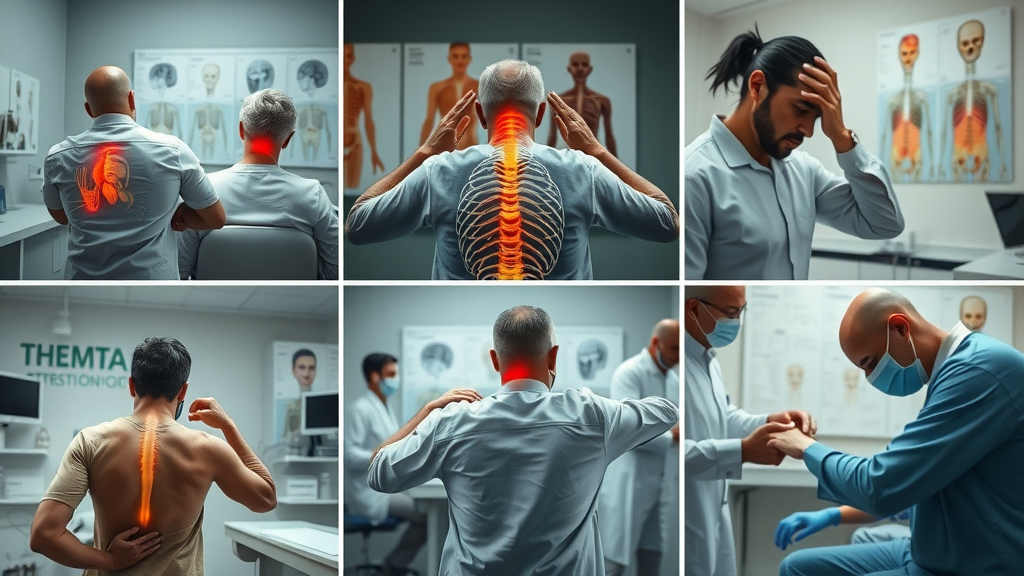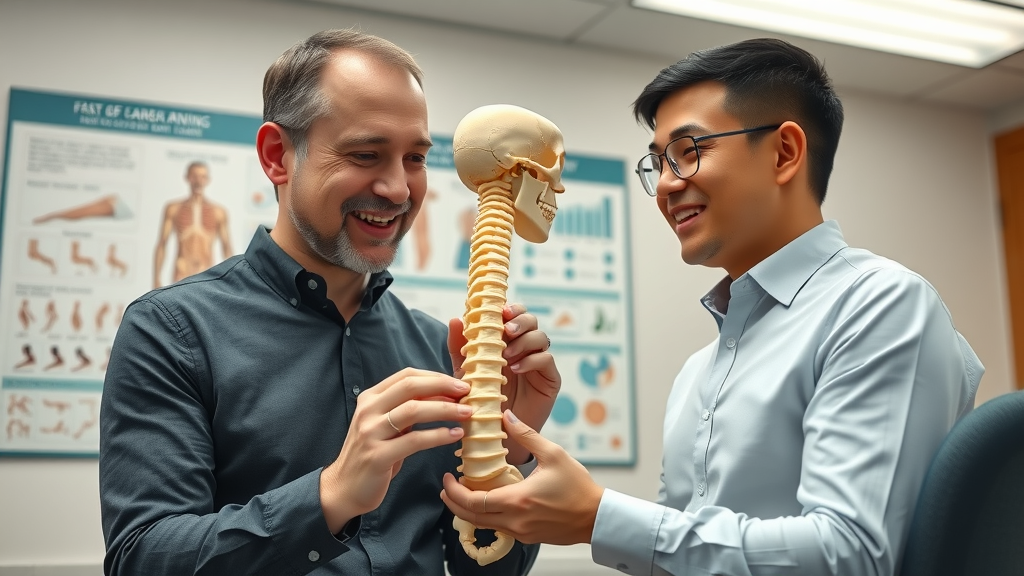Did you know that over 35 million Americans visit chiropractors each year for quick, effective relief from pain and discomfort? Combine this with a growing body of research supporting chiropractic care, and you have one of the most popular non-invasive pain solutions available today. If you’re tired of living with low back pain , neck pain , or other chronic aches, learning about how chiropractors work could be your first step back to wellness. This comprehensive guide breaks down what chiropractors do, how they help, what to watch out for, and why their care is so trusted and effective—so you can take control of your pain and get back to living your life.

Pain Relief by Chiropractors: Surprising Statistics and Key Insights
Every year, millions of people across the United States turn to chiropractors for rapid, lasting pain relief. Unlike traditional primary care providers who may focus on prescription medication or invasive procedures, chiropractors center their approach on spinal adjustment , holistic evaluation, and hands-on therapy. Studies show that up to 77% of patients report significant satisfaction with chiropractic care, noting fast recovery times and a decrease in symptoms that makes everyday life more comfortable and active.
With an emphasis on the musculoskeletal system , chiropractors are uniquely equipped to resolve problems stemming from the spine, joints, and connected tissues. Their careful assessments and targeted adjustments aim to restore alignment, reduce restriction, and promote the body's natural healing. In fact, the continued rise in chiropractic visits underlines their role as a top choice for safe, non-invasive pain solutions within the broader U.S. healthcare profession .
As awareness of opioid risks and the downsides of dependency grows, more Americans are seeking alternatives like chiropractic care. This shift reflects greater trust in drug-free pain management and the value of personalized, comprehensive treatment plans. Whether you're battling ongoing back pain or looking for preventive care, the evidence strongly supports giving chiropractors a closer look.
Did You Know? Over 35 Million People in the United States Visit Chiropractors Annually
This astonishing figure illustrates just how widespread the use of chiropractic care has become. The steady growth in patient numbers reveals not just the popularity, but also the perceived effectiveness of chiropractors as part of the modern health care landscape. With their focus on chiropractic adjustment and patient-centered plans, chiropractors treat far more than occasional aches—they address the roots of pain and dysfunction for diverse groups of men, women, and children nationwide.
Importantly, high satisfaction rates in these millions of visits also suggest that patients view chiropractors as trusted partners in their overall wellness journey . From teenagers with sports injuries to seniors who want to stay active, people are experiencing fast, meaningful relief that lets them get back to enjoying life.
| Approach | Effectiveness | Average Recovery Time | Typical Cost | Patient Satisfaction |
|---|---|---|---|---|
| Chiropractic Care | High for musculoskeletal pain ( back pain , neck pain ) | Faster (days to weeks) | Moderate (~$60–$200/session) | Very High |
| Primary Care / Prescription Drugs | Moderate, symptom-focused | Varies (weeks to ongoing) | Low to moderate (insurance variable) | Moderate |
| Physical Therapy | High (depends on issue) | Moderate (weeks to months) | High (~$100–$350/session) | High |
| Surgery | High for severe/chronic conditions | Slow (months for full recovery) | Very High (thousands, insurance variable) | Low to Moderate (risk of complications) |
"Chiropractors have helped millions reclaim their quality of life—fast and safely—using non-invasive techniques."

What Chiropractors Offer: The Core of Chiropractic Care
- Comprehensive assessment of musculoskeletal conditions
- Personalized chiropractic care plans
- Use of spinal adjustment and spinal manipulation techniques
- Focus on non-invasive, drug-free relief
Chiropractors are primary care professionals specializing in the diagnosis and treatment of conditions affecting the musculoskeletal system . Their goal is to enhance overall health through methods rooted in hands-on therapy, education, and prevention. With advanced training in chiropractic adjustment and a holistic view of patient wellness, these health experts tailor care plans for each individual’s needs.
Upon an initial visit, a chiropractor conducts a thorough assessment—examining posture, movement, joint function, and spinal health. By identifying misalignments or areas of restricted motion, they craft a plan designed to correct dysfunction, alleviate pain, and bolster the body's self-healing capabilities. This approach stands in stark contrast to the "treat-the-symptom" model, emphasizing instead long-term relief and sustained well-being.
For those interested in the specific hands-on methods that set chiropractic care apart, exploring a detailed overview of chiropractic techniques that transform your health can provide valuable insight into the range of adjustments and therapies used to achieve fast, lasting results.
Chiropractic Care Explained: Principles and Science
The foundation of chiropractic care is rooted in the understanding that proper alignment of the spine and joints is crucial for optimal function of the nervous system. Chiropractors employ specific adjustments and spinal manipulation techniques to restore balance, reduce nerve irritation, and improve communication between the brain and body. Numerous studies highlight the efficacy of these interventions, especially in treating pain without resorting to drugs or surgery.
Beyond hands-on adjustments, chiropractors educate patients about posture, ergonomics, and lifestyle changes to prevent future issues. Their practice is supported by rigorous chiropractic education and ongoing professional development—ensuring they remain current with clinical guidelines and emerging science in the healthcare field.
Recent advances also demonstrate that chiropractic methods can alleviate not only low back pain and neck pain but also headaches, joint discomfort, and muscle tension. Chiropractic care is increasingly recognized as a key piece of the integrated health puzzle, often working alongside primary care physicians and physical therapists for maximum patient benefit.
Chiropractors Treat More Than Back Pain
While many associate chiropractors solely with spinal conditions, these experts are trained to address a wide range of musculoskeletal complaints. Chiropractors treat not just back pain , but also chronic headaches, neck stiffness, joint pain, sciatica, and repetitive stress injuries. Their techniques promote pain relief , improved flexibility, and better mobility for all ages.
They often support patients dealing with sports-related injuries, postural fatigue from office work, or even restrictions due to aging. By focusing on the root causes—such as misalignment or muscle imbalance—chiropractors provide tailored remedies that empower patients to regain function and prevent recurrence. This breadth of expertise sets them apart as holistic, whole-body care providers.

How Chiropractors Deliver Fast Pain Solutions
Chiropractors employ a unique combination of specialized techniques and deep anatomical knowledge to provide rapid relief. With spinal adjustment as the centerpiece of their care, they correct misalignments to unlock nerves and improve blood flow, often offering noticeable improvement after just one or two sessions. Many patients experience reduced inflammation, less muscle tension, and enhanced range of motion almost immediately.
What truly distinguishes chiropractic care is its patient-centered approach—focusing on your specific symptoms, lifestyle, and health goals. By addressing the underlying source of discomfort, chiropractors help patients dodge a cycle of chronic pain and dependency on medication. Their quick, non-invasive interventions can make a profound difference for individuals seeking to return to work, sports, or simply a life without daily discomfort.
Case studies consistently demonstrate that timely chiropractic intervention can dramatically shorten recovery periods for conditions like acute low back pain, neck pain, and even migraine flares. By restoring proper movement and supporting tissue repair, chiropractors empower you to get back to the activities you love—faster than many traditional alternatives.
Spinal Adjustment: The Backbone of Chiropractic Treatment
The hallmark of chiropractic care is the spinal adjustment , a precise manual technique aimed at improving joint alignment and mobility. Using measured, controlled force, chiropractors target restricted or misaligned vertebrae—freeing pinched nerves and promoting healthier overall biomechanics. This process can provide immediate relief for tension, soreness, and movement limitations.
Scientific literature affirms that spinal adjustments are highly effective in treating acute and chronic musculoskeletal conditions—especially low back pain. When compared to medication-driven treatments, patients receiving chiropractic adjustment often report faster reduction of pain and fewer side effects. Chiropractors are extensively trained to perform adjustments safely on patients of all ages and fitness levels, further contributing to the method's rising popularity.

Spinal Manipulation Techniques And Their Role in Recovery
Spinal manipulation encompasses a range of hands-on procedures designed to mobilize restricted joints and relax tight muscles. Techniques such as the diversified adjustment, Gonstead method, and Thompson drop-table are all commonly practiced by chiropractors in the United States . Each technique is selected based on a patient’s age, build, and specific symptoms to maximize comfort and improvement.
Recent studies, including peer-reviewed reviews and reports from the American Chiropractic Association , indicate that spinal manipulation can decrease pain scores, reduce inflammation, and help restore normal movement patterns. This intervention is especially valued for its low risk profile and avoidance of pharmaceuticals. Consistent use of skilled spinal manipulation helps countless patients avoid surgery or long-term medication, supporting better outcomes in holistic health care.
For those with repetitive strain injuries, sports injuries, or postural fatigue, chiropractors utilize spinal manipulation to realign the body and promote healing. In this way, chiropractic care combines science and art—adapting time-tested manual therapies to the unique situation of each patient.
Understanding Chiropractic Adjustment: Steps to Relieving Pain
Every chiropractic appointment follows a careful, systematic process to ensure effective and safe care. It begins with a discussion of symptoms and health goals, followed by a thorough assessment of movement patterns and spinal alignment. The chiropractor then develops a plan—often including soft-tissue work, mobilization, and the main chiropractic adjustment . Adjustments are performed with the patient in comfortable positions on a specialized table, ensuring support and relaxation throughout the procedure.
During the adjustment, a controlled force is applied to a targeted joint, often accompanied by a characteristic "popping" sound. This release signals a restoration of function and is usually followed by immediate relief. Chiropractors provide aftercare guidance—such as gentle stretches, posture advice, and lifestyle tips—to help prevent a return of symptoms. Continuous evaluation and adaptation of your care plan ensure lasting results and ongoing improvement.
Key Benefits of Chiropractic Care with Chiropractors
- Drug-free pain relief
- Improved movement and flexibility
- Addressing headaches, back pain, neck pain, and more
- Prevention strategies for chronic issues
One of the standout advantages of working with chiropractors is the focus on drug-free pain relief . Avoiding prescription medications lessens risks of side effects, dependency, or complications. Chiropractic care empowers patients to manage their comfort naturally, promoting true healing rather than masking symptoms.
Chiropractors also emphasize improved mobility. Whether you’re suffering from chronic lows back pain, neck pain, or headaches, chiropractic interventions help restore your ability to move freely and comfortably. By addressing posture, ergonomics, and spinal health, chiropractors provide strategies that not only fix current problems but also prevent recurrence.
The impact on chronic issues is especially significant, as many patients find their quality of life improved through ongoing care. Effective maintenance strategies, personalized guidance, and regular assessments position chiropractic practitioners as long-term partners in your musculoskeletal wellness.

Chiropractors in the United States: Qualifications and Licensing
To practice in the United States, chiropractors must undergo extensive training and meet strict licensing standards. After earning an undergraduate degree, students enter a Doctor of Chiropractic program accredited by the Council on Chiropractic Education . This curriculum combines classroom learning, hands-on training, and clinical internships, covering anatomy, physiology, diagnostic imaging, and core chiropractic techniques.
Graduates must then pass a rigorous series of national and state board examinations, such as those administered by the National Board of Chiropractic Examiners . Some states require additional certifications or ongoing continuing education to maintain licensure. Chiropractic physicians are also governed by the Board of Chiropractic Examiners and adhere to ethical codes set by professional bodies like the American Chiropractic Association and the Council on Chiropractic Education .
This robust education ensures patients receive care from highly trained experts. The emphasis on continuing education keeps chiropractors up to date on the latest evidence-based practices, reinforcing their standing as trusted health care professionals in the broader American health system.
Common Conditions Chiropractors Treat and Their Methods
- Lower back pain
- Neck pain
- Headaches and migraines
- Joint issues
- Sciatica
- Sports injuries
Chiropractors are recognized for their expertise in resolving a variety of musculoskeletal complaints. Low back pain is perhaps the most common reason patients seek chiropractic care, with spinal adjustments, joint mobilization, and soft-tissue therapies delivering fast, meaningful relief. Similarly, techniques for neck pain focus on restoring alignment and reducing muscular tension, which frequently leads to improved posture and less day-to-day discomfort.
Headaches and migraines are also frequently addressed through chiropractic care, as tension in the spine and neck often contributes to these symptoms. For joint issues, sciatica, and sports injuries, chiropractors devise customized treatment plans aimed at both symptomatic relief and functional restoration. The combination of hands-on adjustments, stretching, and patient education supports a return to normal activity with less risk for recurrence.

Chiropractic Treatment Techniques Employed by Chiropractors
Manual Therapies: Beyond Spinal Manipulation
While spinal manipulation is central to chiropractic care, practitioners also employ a variety of manual therapies to enhance healing. Massage therapy, trigger point release, soft-tissue mobilization, and stretching techniques are used to reduce inflammation, increase circulation, and promote relaxation of tight muscles. These hands-on approaches can be especially helpful for patients with sports injuries, chronic muscle knots, or repetitive strain complaints.
By combining spinal adjustments with manual therapies, chiropractors offer a comprehensive strategy for pain management and prevention. These complementary techniques target the fascia, ligaments, and muscles supporting the spine, ensuring longer-lasting improvements in comfort and function. Patients often report decreased soreness, improved movement, and faster recovery after integrating these methods into their care plans.
Many modern chiropractic clinics also provide ergonomic education and individualized exercise prescriptions. This proactive element empowers patients to take control of their musculoskeletal health beyond the clinic walls, reinforcing the benefits of professional care at home or on the job.
Modern Tools and Technology in Chiropractic Care
Today's chiropractors combine centuries-old manual traditions with cutting-edge tools and diagnostics. Digital x-rays, computerized posture assessment, and motion analysis software all allow practitioners to pinpoint problem areas and measure progress with precision. Some clinics utilize instrument-assisted adjustments, laser therapy devices, or electronic stimulation to complement traditional adjustments.
The integration of high-tech equipment helps chiropractors tailor treatments more effectively, track objective improvements, and communicate findings clearly to patients. These tools contribute to a more personalized care experience, enhancing both short-term symptom relief and long-term health outcomes. As the field evolves, technology continues to play a pivotal role in expanding the reach and efficacy of chiropractic treatment in the United States.

Are Chiropractors Right for Your Pain? What Science and Experts Say
"Current research confirms significant pain relief and quality of life improvements from chiropractic care—often faster than medication-based strategies."
– Dr. Jane Matthews, Pain Specialist
| Study | Condition | Results | Patient Population |
|---|---|---|---|
| JAMA Network, 2022 | Low back pain | Faster pain relief vs. medication; improved mobility | Adults (18–65) |
| Spine Journal, 2020 | Neck pain, headaches | Reduced pain intensity; higher satisfaction | Teens, Adults |
| BMJ Open, 2019 | Chronic musculoskeletal pain | Sustained benefits over 6 months | Diverse (all ages) |
Leading research and expert consensus affirm that chiropractic care is highly effective for a broad range of musculoskeletal complaints. For individuals in the United States seeking safer alternatives to prescription drugs or surgery, chiropractors offer evidence-based solutions that get you back to function—quickly and safely.
However, the best results are often achieved when chiropractic methods are integrated into a comprehensive care plan. Collaboration with primary care doctors, physical therapists, or specialists further enhances outcomes—helping you access the widest range of expertise possible for your unique situation.
Evaluating the Risks: What Are the Red Flags and Limitations of Chiropractors?
Recognizing the Red Flags: When to Seek Alternative Care
While most chiropractic care is safe and beneficial, certain red flags indicate when it may not be appropriate. If you experience sudden, severe pain, numbness, weakness, loss of bladder control, or symptoms unresponsive to conservative care, it’s essential to consult a medical doctor or specialist. Chiropractors are trained to identify cases that require referral, such as suspected fractures, infections, or neurological conditions. Ignoring these warnings could delay proper treatment and put your health at risk.
Additionally, if adjustments lead to increasing discomfort, no improvement occurs after several sessions, or the chiropractor discourages second opinions or imaging, it’s wise to consider other options. Legitimate chiropractors operate within their scope of practice and collaborate with primary care providers for your safety and well-being.
What Leading Institutions Say About Chiropractic Safety
- When not to undergo chiropractic adjustment: Acute trauma, known spinal instability, certain neurological diseases
- Warning signs of ineffective or unsafe chiropractic care: Persistent pain despite care, refusal to provide referrals or collaborate with other providers, reluctance to order imaging if needed
- Importance of doctor referrals: Medical doctors and chiropractors should work together for comprehensive, safe patient care.
Major medical organizations agree: Chiropractic care is generally safe when performed by licensed, qualified professionals. Bodies such as the American Chiropractic Association, Board of Chiropractic Examiners, and Council on Chiropractic Education all stress adherence to evidence-based guidelines and regular collaboration with other health care providers. Most chiropractors welcome these relationships, supporting best practices and positive outcomes for every patient.

The Debate: Why Some Doctors Discourage Chiropractors
"Collaboration between medical doctors and chiropractors ensures optimal patient outcomes—but controversy still exists in the wider medical community."
Despite mounting evidence in support of chiropractic care, some medical doctors remain skeptical. Concerns often stem from a perceived lack of rigorous scientific backing, unfamiliarity with the scope of practice , or historical divisions between professions. There are also debates about claims made by a minority of practitioners who promote unproven treatments or fail to integrate with the broader health system.
Nonetheless, integrated health care models are increasingly bringing chiropractors and medical doctors together, preventing the fragmentation of patient care. When both sides collaborate, patients receive the benefits of holistic, multifaceted expertise that maximizes recovery and minimizes risks. Patients are encouraged to seek providers who value communication, transparency, and a team-based approach.
How Integrated Health Systems View Chiropractic Care
Modern integrated health systems often include chiropractors as part of their provider network—endorsing a team-based approach to musculoskeletal complaints. In such settings, chiropractors consult and co-manage cases with physical therapists, primary care doctors, and even orthopedic surgeons. Research supports that this model improves patient satisfaction, speeds up recovery, and reduces costs by limiting duplicate or unnecessary care.
Whether navigating chronic back pain or considering preventive strategies, choosing a care professional who works well within larger health care teams is a logical step. The most effective results come from open collaboration—drawing from the strengths of diverse care providers to create a personalized plan that puts the patient first.
Chiropractors in the United States: Finding the Right Professional
- Choosing licensed chiropractors
- Questions to ask at your first appointment
- Understanding insurance and coverage
Finding a reputable chiropractor in the United States starts with verifying licensure and credentials. Look for practitioners certified by the appropriate board of chiropractic examiners and recognized by professional organizations such as the American Chiropractic Association. During your initial consultation, ask about their experience treating your specific condition, their approach to care, and how they coordinate with other health care professionals as needed.
It’s also crucial to understand your insurance coverage. Many plans cover chiropractic care for certain conditions such as low back pain or neck injuries. Confirm copay amounts, visit limits, and any required referrals before starting treatment. A transparent and communicative chiropractor will gladly help you navigate the paperwork and maximize your benefits.
Pay attention to your comfort level during the appointment. A good chiropractor should answer questions clearly, discuss all available options, and develop a plan tailored to your goals. Reviews, testimonials, and patient satisfaction ratings are valuable tools in making an informed choice for your health.
| Characteristic | Details |
|---|---|
| Number of Licensed Chiropractors | ~70,000 |
| States with Highest Concentration | California, Florida, Texas, New York |
| Average Patient Satisfaction | 85% (Very Satisfied) |
| Median Years in Practice | 15+ |

Chiropractic Care Myths and Facts: Evidence Behind Chiropractic Adjustment
- Debunking common misconceptions about chiropractic treatment
- Clarifying the science of spinal adjustment and manipulation
- Patient testimonials vs. scientific research
Several common myths persist about chiropractic care, including the idea that it’s only for back pain or lacks scientific basis. In reality, chiropractic adjustment is supported by substantial research, government guidelines, and insurance coverage. Claims that chiropractic adjustments are dangerous or addictive are also unfounded—when delivered by licensed, experienced practitioners, the risk of serious complications is extremely low.
Another frequent misconception is that chiropractic care requires ongoing, endless visits. While some patients benefit from maintenance care, others achieve lasting relief in just a few sessions. Testimonials from countless individuals support both immediate and long-term improvement—from chronic pain to greater mobility and better sleep. However, the strongest endorsement comes from systematic reviews and clinical trials validating spinal manipulation for a range of conditions.
Ultimately, distinguishing fact from fiction ensures that you can make informed decisions. Choose chiropractors who communicate openly, encourage questions, and use evidence-based techniques tailored to your needs.
What does a chiropractor do exactly?
Chiropractors Specialize in: Diagnosing and Treating Musculoskeletal Disorders

Chiropractors are experts in the diagnosis and treatment of musculoskeletal system disorders. Their practice centers on assessing spinal health, movement patterns, and neuromuscular function. Using a combination of spinal adjustment, muscle therapy, and educational guidance, chiropractors address the root causes of pain and dysfunction—helping patients regain flexibility, reduce discomfort, and enhance overall well-being.
They also coordinate with other health professionals, ensuring a comprehensive, patient-centered approach.
Why do doctors discourage chiropractors?
Medical Community Concerns: Lack of Evidence, Scope of Practice, and Collaborative Care
Some medical doctors express concern about chiropractic care due to perceived gaps in research, misunderstandings about scope of practice , or isolated cases of overreach. These concerns are lessening as new evidence emerges and chiropractors embrace collaborative, evidence-based models. Today, an increasing number of integrated clinics consider chiropractors essential contributors to musculoskeletal health—balancing traditional and complementary therapies for superior outcomes.
Open communication, ongoing research, and respect for each provider’s strengths are key to overcoming lingering skepticism. When medical doctors and chiropractors work together, patients benefit from safer, more effective treatment plans with fewer gaps in care.
What are red flags in chiropractic?
Spotting Unsafe Practices in Chiropractic Treatment
Red flags in chiropractic practice include refusal to provide referrals, discouraging diagnostic imaging when clearly warranted, promising to treat non-musculoskeletal diseases with adjustments, or insisting on frequent, long-term visits without clinical evidence. Patients should also be wary if a chiropractor discourages open dialogue with their primary care provider or avoids collaborating with other health care professions.
Trustworthy chiropractors respect clinical boundaries and work transparently with other care providers. Staying informed and asking questions helps safeguard your health while reaping the many benefits of chiropractic care.
Is there any science behind chiropractic adjustment?
Research-Backed Evidence and Ongoing Studies on Chiropractic Effectiveness
Yes, there is robust scientific support for the role of chiropractic adjustment in managing acute and chronic musculoskeletal pain. Major studies demonstrate significant improvements in back pain, neck pain, and headaches among patients receiving regular chiropractic care. Ongoing trials continue to explore its potential for treating sports injuries and postural conditions, as well as its positive impact on patient satisfaction and healthcare costs.
Organizations such as the American Chiropractic Association , Council on Chiropractic Education , and global health bodies routinely cite strong safety profiles and high efficacy rates when chiropractic care is performed by trained professionals. This growing base of evidence positions chiropractors as key players in solutions for fast, non-invasive pain relief.
Frequently Asked Questions About Chiropractors and Chiropractic Care
-
Are chiropractors doctors?
Yes, chiropractors hold a Doctor of Chiropractic degree from an accredited institution and must pass national and state board exams to practice. While not medical doctors (MD), they are licensed health care professionals specializing in musculoskeletal health and chiropractic adjustment . -
Is chiropractic care covered by insurance in the United States?
Many health insurance plans in the United States cover chiropractic services, especially for conditions like low back pain or neck pain. Coverage specifics vary, so it’s best to check with your provider and ask your chiropractor’s office to assist with billing questions. -
What should I expect at my first chiropractic adjustment?
Your first visit typically includes a detailed health history, examination of posture and movement, discussion of symptoms, and a personalized care plan. The chiropractor will explain techniques, answer questions, and ensure your comfort and safety during any adjustments.

Key Insights to Remember About Chiropractors
- Chiropractors offer efficient, non-invasive pain solutions
- Spinal adjustment and chiropractic treatment methods are widely used and increasingly accepted
- Know the red flags, but also the evidence-backed benefits
Empower Your Recovery: Ready to Experience the Benefits of Chiropractors?
Take control of your health and embrace an evidence-backed, drug-free path to pain relief—schedule a visit with a licensed chiropractor today and discover how quickly you can get back to the activities you love.
If you’re inspired to take a more holistic approach to your well-being, consider broadening your perspective beyond pain relief alone. Our in-depth guide on holistic medicine and integrative health strategies explores how combining chiropractic care with other natural therapies can elevate your overall vitality. Discover how a comprehensive, whole-person approach can help you achieve lasting wellness, prevent future issues, and unlock your body’s full potential. Take the next step in your health journey by learning how integrative practices can complement the fast pain solutions offered by chiropractors.
Chiropractic care offers a range of benefits beyond pain relief, including improved posture, enhanced sleep quality, and reduced stress levels. For instance, the article “Chiropractic Benefits: 10 Advantages of Chiropractic Care” highlights that spinal adjustments can alleviate neck pain and reduce reliance on opioid pain relievers. ( healthline.com ) Additionally, “Top 12 Benefits of A Chiropractic Adjustment” discusses how chiropractic care can enhance joint health and improve balance. ( centerforspineandortho.com ) If you’re seeking a holistic approach to wellness, these resources provide valuable insights into the multifaceted advantages of chiropractic treatments.
 Add Row
Add Row 

 Add
Add 


Write A Comment